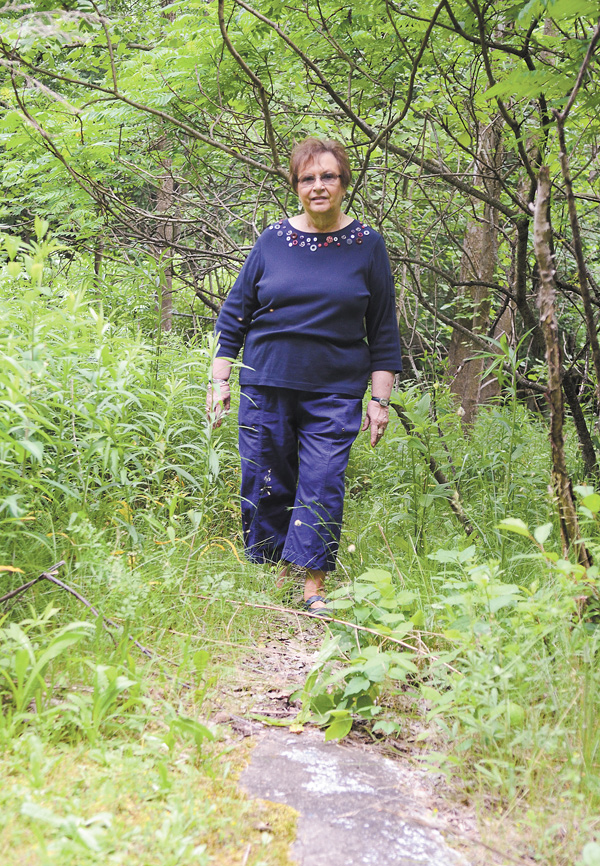Struthers officials remember summers spent at the Birdbath


Barbara Tesyk, a 1957 graduate of Struthers High School and the city’s deputy tax clerk, walks along a small portion of what used to be Struthers Municipal Pool in Yellow Creek Park.
By EMMALEE C. TORISK
STRUTHERS
The gently sloped slab of concrete that pokes out from beneath a grassy path in Yellow Creek Park, right off Wetmore Drive, seems fairly nondescript.
But to those who know what they are looking at — including Shirley Sepesy, the city’s litter control and recycling coordinator and a 1976 graduate of Struthers High School — the sight is a reminder of hot summer days not all that long ago, when it seemed the entire city congregated in that wooded corner of the park for hours at a time: to swim, to sunbathe, to be with others.
After all, that slab once belonged to the outer portion of the Struthers Municipal Pool, perhaps better known as “the Birdbath,” which was dedicated Aug. 23, 1939, and for the next 40 years was patronized by generations of city residents.
Now, that concrete is all that remains. Most everything else has been overtaken by nature.
“It was a nice place to go,” said Sepesy, who spent a high school summer working at the Birdbath, collecting pool admission tickets and issuing storage baskets at the bathhouse. “It used to be packed.”
That’s also how Barbara Tesyk, the city’s deputy tax clerk and a 1957 Struthers graduate, remembers the Birdbath, with its distinctive circular shape and its central location between both sides of the city. Everyone walked there, she remarked, whether it was to attend the early-morning swimming lessons offered by the Red Cross, or to launch themselves off the diving boards in the pool’s middle, or simply “to see who was there.”
“It was a wonderful thing to do in the summer,” Tesyk said. “In Struthers, it was the place to go.”
Capt. Pat Bundy of the Struthers Police Department added: “Growing up, that was what you did.”
This phenomenon — of a municipal pool serving as a center of community life during the summer — wasn’t unique to Struthers, however.
In “Contested Waters: A Social History of Swimming Pools In America,” Jeff Wiltse, an associate professor of history at the University of Montana, explains that during the 1920s and 1930s, more than 1,000 cities and towns across the U.S. opened swimming pools. Though much of this construction slowed with the start of the Great Depression, it resumed in the early 1930s and continued for the remainder of the decade, thanks to New Deal programs such as the Public Works Administration, a construction agency created to spur economic recovery.
The Lincoln Tunnel in New York City and the Grand Coulee Dam in Washington state were among the PWA’s projects, but so were municipal swimming pools like the Birdbath, which was approved for $24,545 in funding by federal officials in December 1938, according to Vindicator files.
On Dec. 29, 1938, just days later, construction officially began on the pool, which stretched 215 feet long and 162 feet wide, with a maximum depth of 9 feet, and was located on the park’s old picnic grounds.
When the $60,000 pool opened eight months later, The Vindicator reported that it was the product of two decades’ worth “of planning by civic-minded residents” — and touted the steel fence surrounding the diving area, the fenced-off wading ponds at either end and the central island that included “a loud speaking system.”
At one time, said Ed Wildes, the city’s safety-service director and a 1964 graduate of Struthers, the Birdbath really “was a beautiful pool” that had an underwater observation room, a fully stocked concession stand and benches positioned all around it.
Even Mayor Terry Stocker, who graduated from Struthers in 1967, can still recall running through the pool’s water on chilly summer mornings, an exercise that was part of the high school football team’s conditioning program, and then struggling to walk up the steep Wetmore Drive hill to go home after a full day of swimming.
“We used to spend the whole day there,” he said. “Too bad we couldn’t go back to that. But would kids [today] even come?”
Stocker was also there for the Birdbath’s end, when it was replaced by a new $273,000 pool built at Mauthe Park on the city’s south side. Ground was broken for the pool and bathhouse, which like the Birdbath was funded by a federal grant, on Jan. 18, 1978, according to Vindicator files.
Though it was “well run,” Stocker said, declining attendance at the municipal pool — something that occurred nationwide as a result of the backyard-pool boom in the decades following World War II, Wiltse notes — and the need for expensive repairs forced its closure in the mid-1990s. Another pool never replaced it.
Marian Kutlesa, founder of the Struthers Historical Society, said she understands why the city’s owning a pool is no longer feasible, but that the community is “lacking something” as a result. In particular, she misses the uniquely designed, “very safe” Birdbath, which nearly every Struthers resident knew of and frequented.
“I just think it was too bad,” Kutlesa said. “To have a city pool is a darn good thing.”
 43
43
